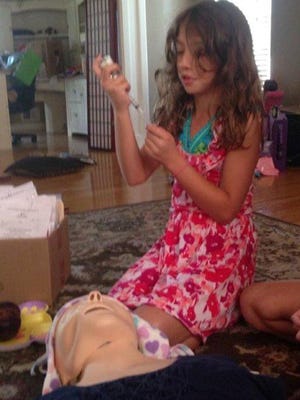Ky. group to train kids on how to use heroin antidote

CINCINNATI — In an indication of how entrenched heroin is in families across the nation, a Kentucky group is about to teach children how to reverse an overdose with a life-saving drug.
Audrey Stepp is 8, and she already knows how to do it.
Her big brother, now 25, has struggled with addiction disease her whole life, and their mother leads the community-based Bullitt County Opioid Addiction Team.
"She has heard me all through the day. All through the night, helping people," said Jennifer Stepp. "She said, 'Mom. Why haven't you trained me in naloxone?' "
Next month, Stepp plans to teach other children how to use the non-narcotic that can restore breathing in those overdosing.
Heroin use surges, addicting more women and middle-class
"People will think this is very controversial," Stepp said. "I'm OK with that."
"This is telling them, if you do find a brother, sister, mother, uncle, not breathing, here's something that you can do about it," said Dr. Mina "Mike" Kalfas, a certified addiction expert in northern Kentucky who has somewhere near 300 heroin-addicted or recovering patients.
"These kids are realizing that drugs can kill them. This is part of an environment where they might find someone dead (due to heroin overdose)," Kalfas said.
A company that makes a naloxone-administering device similar to the Epi-pen has donated Evzio kits for Stepp's training. The Food and Drug Administration approved the treatment in 2014 for reviving those overdosing on heroin or prescription painkillers.
Eliza Wheeler, project manager for the pioneering national advocacy organization Harm Reduction Coalition, wasn't aware of training specifically for children. But she said younger kids with addiction have been trained, and some parents are training their own kids to use naloxone.
Heroin trends up
How common is it for a child to have a family member hooked on heroin or prescription painkillers?
No one knows, but with the skyrocketing overdose cases, it's evident that many children are feeling the impact of heroin.
According to the Centers for Disease Control and Prevention, "the rate of heroin-related overdose deaths nearly quadrupled" between 2002 and 2013. More than 8,200 people died in 2013, the CDC said.
Report: Drug overdose death rates increase in 26 states
A Kentucky Health Issues Poll in 2014 revealed that in northern Kentucky, 26% of those surveyed knew someone with a heroin problem. The poll also showed that 28% of adults responding said they have family or a friend with problems stemming from prescription pain medicine.

Another sign of heroin's prevalence in children's homes are child protection cases.
Heroin is climbing as a contributing factor in such cases in Ohio. Child Protection Services cases mentioned heroin as a case factor 3,726 times, or 4.9%, of the 75,430 caseload in 2010. That compares to 6,827, or 8.9%, of the 76,283 cases in which heroin was noted as present in 2013. (The Ohio Department of Job and Family Services cautioned that just because heroin was noted doesn't mean that a parent was using it.)
Kentucky's Department for Community Based Services doesn't specifically track heroin in its Child Protection Services cases. But a spokeswoman said cases in which substance use is a factor in the agency's involvement with children are climbing.
Experts weigh in
Libby Harrison, project manager for needle-exchange service Cincinnati Exchange Project, is supportive of Stepp's endeavor.
"I see nothing but good in this," said Harrison. "Naloxone is so easy to use, a kid can do it safely. Doing this also helps a child avoid the lifelong trauma of watching a loved one die."
As heroin deaths rise, parents learn to give antidote
Dr. Judith Feinberg, an infectious diseases expert and professor of medicine at the University of Cincinnati said she is "sort of pro," as long as children are not traumatized and they know their first step should be to run to an adult, if one is nearby.
Kalfas is steadfast in backing the effort to train kids.
"This is a great message for kids who are 8, 9, 10 years old. Because at 11 years old, these kids are going to be faced with someone who wants them to take drugs," he said. And he added that when naloxone is ingested by someone who hasn't been taking opioids or using heroin, it has no effect.
"The worst thing that can happen is just nothing. So what?"
Kids want to help
Stepp said she "wouldn't dare give a kit" to just any child, and that parents or guardians must attend the training session and approve of it before she'd train a child to use naloxone.
But it appears more children want to help fight the epidemic.
Alexius Rabanus, 17, of Hebron, Ky., whose mother now chairs Northern Kentucky People Advocating Recovery, recently asked her mother to be trained.
Kristie Blanchet said she will do it.
Alexius views it this way: "It's important for the community to step up and try to help people. I hate to see people who have the ability to be saved not saved."